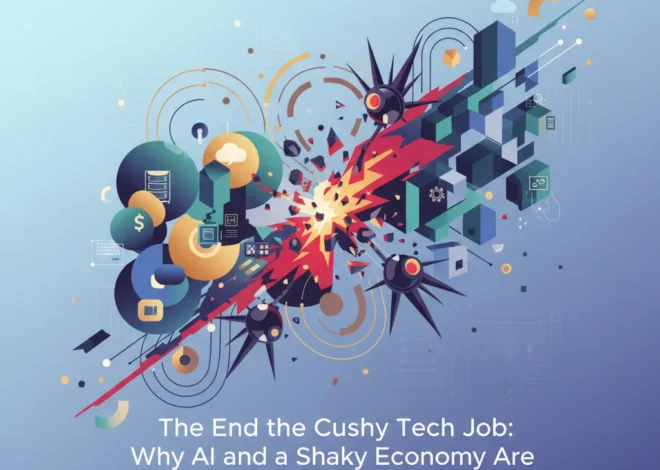
The AI Bubble: Are We Repeating History’s Costliest Financial Mistakes?
The global stock market has found its new darling, and its name is Artificial Intelligence. Companies like Nvidia have seen their valuations soar to trillions of dollars, a meteoric rise fueled by an intoxicating narrative of world-changing technology. The excitement is palpable, with every sector from finance to healthcare scrambling to announce its “AI strategy.” But for seasoned veterans of the market, this frenetic energy feels eerily familiar. It carries the distinct echo of past manias, from the dotcom boom of the late 90s to the more recent crypto frenzy.
This sense of déjà vu was recently crystallized in a letter to the Financial Times by Professor Feng Li of Bayes Business School. He posits a compelling, if unsettling, thesis: we are in the midst of a classic AI bubble. The promise is revolutionary, but the current reality is often mundane, and the market’s valuation has become dangerously detached from fundamental value.
Is this time different? Or are investors, captivated by the allure of generative AI, marching confidently towards a familiar cliff? This article will dissect the anatomy of the AI hype cycle, draw critical parallels with past bubbles, and provide a strategic framework for investors and business leaders to navigate the turbulence ahead.
The Anatomy of a Tech Bubble: A Walk Down Memory Lane
Before we can diagnose the present, we must understand the past. A technology bubble isn’t just about rising stock prices; it’s a psychological phenomenon driven by a powerful narrative. It typically follows a predictable pattern: a groundbreaking innovation emerges, capturing the public imagination. Early pioneers see incredible returns, attracting a flood of less-informed capital. The media amplifies the hype, and a “fear of missing out” (FOMO) mentality takes hold, pushing valuations to irrational heights. The narrative of a “new paradigm” is used to justify metrics that would be unacceptable in any other context.
We saw this play out with breathtaking speed during the dotcom era. The promise was that the internet would fundamentally reshape commerce and communication. Companies with “.com” in their name, many with no revenue or clear business model, achieved billion-dollar valuations overnight. The bubble burst spectacularly in 2000-2001, wiping out an estimated $5 trillion in market value and shuttering countless startups.
More recently, blockchain and cryptocurrencies followed a similar arc. The revolutionary promise of decentralization and a new financial system fueled a speculative frenzy in assets like Bitcoin and countless “alt-coins.” The boom was characterized by Initial Coin Offerings (ICOs) and NFTs, where hype often overshadowed utility. While the underlying blockchain technology holds value, the bubble led to massive losses for many retail investors when the market corrected.
These historical precedents provide a crucial lens through which to examine the current AI boom. The patterns of an exciting new technology, a compelling narrative, and soaring valuations are all present. The critical question for today’s investing landscape is whether the substance of AI can ultimately justify the speculation.
Beyond the 2008 Ghost: Why Europe's Securitisation Market Deserves a Second Look
Echoes of the Past: Comparing Tech Hype Cycles
Professor Li’s letter highlights that while the technology changes, the human behavior driving the hype remains remarkably consistent. To illustrate this, let’s compare the three most significant tech waves of the last quarter-century.
| Characteristic | Dotcom Bubble (~1997-2001) | Blockchain/Crypto Bubble (~2017-2021) | AI Bubble (~2022-Present) |
|---|---|---|---|
| The Grand Promise | A frictionless global economy powered by the internet. | A decentralized, trustless world, free from intermediaries. | Human-level intelligence, automated creativity, and solutions to humanity’s biggest problems. |
| The “Killer App” | E-commerce websites and online portals. | ICOs, NFTs, and DeFi protocols. | Large Language Models (LLMs) like ChatGPT and generative image tools. |
| The Buzzword | Adding “.com” to a company name. | “On the blockchain” or “crypto-enabled.” | “AI-powered” or “leveraging generative AI.” |
| The Investment Narrative | “Eyeballs” and “network effects” are more important than profit. | “It’s a new asset class; traditional valuation doesn’t apply.” | “The market for intelligence is infinite; get in on the ground floor.” |
| The Reality Gap | Immature infrastructure, low internet penetration, and a lack of viable business models. | Scalability issues, regulatory uncertainty, and limited real-world use cases beyond speculation. | Extremely high computational costs, data privacy concerns, factual “hallucinations,” and a talent shortage. |
The parallels are striking. Just as “clicks” and “eyeballs” were the dubious metrics of the dotcom era, the number of parameters in an AI model or the speed of its adoption are now heralded as signs of inevitable success, often divorced from profitability. The core argument of the sceptic is not that AI is useless, but that its path to widespread, profitable integration into the economy will be far longer, costlier, and more complex than current stock prices suggest.
Promise vs. Practice: The Sobering Reality of AI Implementation
Beyond the frothy stock market, what is the reality of AI in the corporate world? As Professor Li notes, many so-called “AI revolutions” are simply “old wine in new bottles”—sophisticated data analysis or automation tools rebranded for the current zeitgeist. While generative AI is a genuine breakthrough, its practical application in enterprise settings is fraught with challenges.
A recent report on AI adoption highlights several key hurdles that businesses face. According to a 2023 IBM study, the top barriers to AI adoption include limited AI skills and expertise (33%), overly complex data (25%), and concerns around AI ethics and bias (23%). This isn’t a simple plug-and-play technology. Implementing AI effectively requires:
- Massive Computational Resources: Training and running large models is astronomically expensive, consuming vast amounts of energy and requiring specialized hardware that is in short supply.
- Clean and Relevant Data: An AI model is only as good as the data it’s trained on. Most organizations have messy, siloed data, making effective implementation a significant data engineering challenge.
- Specialized Talent: There is a severe global shortage of AI engineers, data scientists, and machine learning specialists, making talent acquisition a fierce and costly battle.
- Risk and Compliance: Issues around data privacy, copyright infringement, and the tendency of models to “hallucinate” (invent facts) create significant legal and reputational risks for businesses in sectors like banking and healthcare.
This reality check is crucial. The journey from a captivating ChatGPT demo to a reliable, secure, and profitable enterprise application is a long and arduous one. The market, however, seems to be pricing in a seamless and immediate transition.
The Great Economic Card Trick: Are You Watching the Wrong Hand?
Navigating the Hype: A Strategic Guide for Prudent Investing and Leadership
Acknowledging the signs of a bubble doesn’t mean one should run for the hills. The internet was a revolutionary technology, and investors who bought Amazon or Google *after* the dotcom crash and held on saw life-changing returns. The key is to separate the technology from the hype and act with strategy, not emotion.
For Investors in Finance and Fintech:
- Focus on Fundamentals: Look beyond the narrative. Scrutinize company balance sheets, cash flow statements, and profitability metrics. Is the company’s valuation justified by its current or reasonably projected earnings? Or is it priced for a perfect, multi-decade future?
- Diversify Your Bets: Avoid concentrating your portfolio in the most hyped-up names. Spread your investments across the AI value chain—from the “picks and shovels” (semiconductors, infrastructure) to established software companies integrating AI, to more speculative pure-plays.
- Understand the Tiers: Differentiate between the foundational model builders (like OpenAI, Google), the infrastructure providers (like Nvidia, AWS), and the application layer companies (startups building on top of the models). The risk and reward profiles are vastly different at each level.
- Embrace a Long-Term Horizon: Volatility is a given. If you believe in the long-term transformative power of AI, be prepared for significant corrections along the way. Market timing is a fool’s errand; time *in* the market with quality assets is a more proven strategy for trading and investing.
For Business Leaders:
- Solve Problems, Don’t Chase Trends: Start with a genuine business problem, not with the mandate to “use AI.” Where are your biggest inefficiencies? Where can you create the most value for your customers? Apply AI as a tool to solve those specific issues.
- Start Small and Prove ROI: Instead of launching a massive, company-wide AI overhaul, begin with small, manageable pilot projects. Measure the results, demonstrate a clear return on investment, and then scale what works.
- Invest in Your Foundation: The most critical investments are not in the latest AI model but in your data infrastructure and your people. A clean, accessible data pipeline and a team with the right skills are the prerequisites for any successful AI strategy.
The Trillion-Dollar Handshake: Unpacking the Global Economic Stakes of the Trump-Xi Summit
Conclusion: Cautious Optimism in the Age of AI
Artificial Intelligence is undoubtedly one of the most profound technological shifts of our lifetime. Its potential to reshape industries, boost productivity, and advance science is real and immense. But the technology’s long-term potential and the market’s short-term valuation are two very different things. The current frenzy in the stock market shows all the classic signs of a speculative bubble, driven by a powerful narrative that has outpaced the on-the-ground reality.
By learning from the painful lessons of the dotcom and crypto bubbles, we can approach the AI revolution with a healthy dose of scepticism and strategic foresight. The goal is not to dismiss the technology but to resist the mania. For investors and leaders, the challenge is to look past the hype, focus on fundamental value, and make disciplined decisions. The AI-powered future will eventually arrive, but the path there will be paved with both incredible opportunities and the wreckage of those who let euphoria cloud their judgment.


